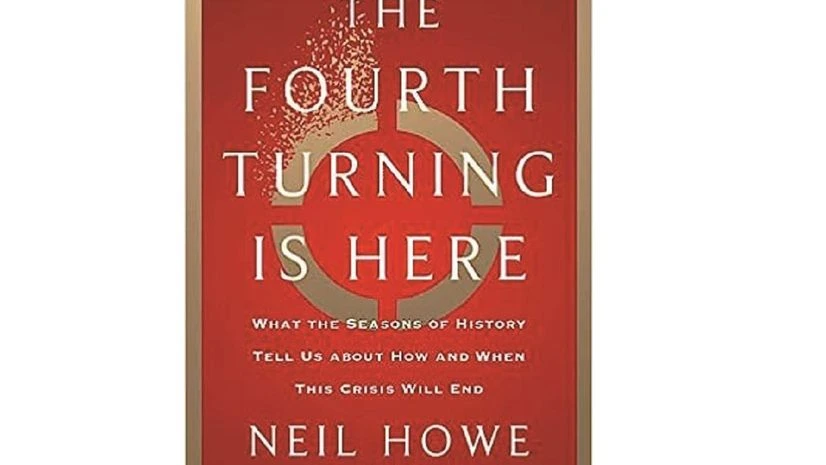The Fourth Turning Is Here: What the Seasons of History Tell Us about How and When This Crisis Will End
Author: Neil Howe
Publisher: Simon & Schuster
Pages: 578
Price: $32.50
Also Read
End Times: Elites, Counter-Elites, and the Path of Political Disintegration
Author: Peter Turchin
Publisher: Penguin Press
Pages: 352
Price: $28
Over the past decade, many Americans have developed a deep foreboding that their society has fallen into crisis. Ever-growing polarisation, economic inequality and inflation have stoked a feeling on both the left and the right that the country’s once revered political institutions have become dysfunctional and illegitimate. Particularly since the Russian invasion of Ukraine, the crisis has taken on a geopolitical dimension, leading many to fear that the present is far more dangerous than any other period in their lifetimes.
Against this background we have the publications of Neil Howe’s The Fourth Turning Is Here and Peter Turchin’s End Times. Both books affirm the idea that we are in the midst of a major crisis and use history to predict how the crisis might be resolved. Both authors had predicted, by a decade or more, that a period of great crisis would arrive around 2020, though neither foresaw a pandemic.
Turchin is a former theoretical biologist and a self-described specialist in “cliodynamics,” a variety of Big Data analysis that makes predictions by applying mathematical models to a huge database of prior historical crises stretching back several millennia.
He proposes a cyclical scheme of societal rise and subsequent disintegration based on a “wealth pump,” whereby elites get richer and ever more entrenched. Inequality, if left unchecked, grows to the point that the system fragments and has to be rebuilt from the ground up. Such is the situation today in America, where oligarchy has become so extreme that a huge redistribution of power needs to take place.
Howe’s book is a sequel to his 1997 work The Fourth Turning (written with the political satirist William Strauss, who died in 2007). The earlier text is one of the Trump acolyte Steve Bannon’s favourite books and its two authors were credited with inventing the term “millennial” to describe the generation born from the mid-1980s throughthe 1990s.
Howe writes that Anglo-America has gone through five century-long “saecula” and is now at the end of a sixth. Each saeculum encompasses four generations corresponding to the seasons of the year. There is a “High” (spring) period, a new beginning; an “Awakening” (summer) when the next generation turns against its parents; an “Unraveling” (fall) when institutions start to decay; and a “Crisis” (winter) when everything falls apart, preparing the way for a new saeculum.
Each Turning produces its own character type (“Prophet,” “Nomad,” “Hero,” “Artist”). According to Howe, we are now in the Crisis stage or “Fourth Turning” of the Millennial Saeculum that began after World War II. “Winter is here,” he announces, and we can expect a new First Turning sometime in the 2030s.
If this all sounds a bit too neat, it is. His periodisation is very arbitrary. The biggest sore thumb is the “High” of 1865 to 1886, a stretch of years following the crisis of the Civil War when a newly reunified America was born. He describes this period of continuous partisan struggle when the country could not decide whether it was a fundamentally agrarian or urban-industrial society as a hiccup in his scheme; this “High” saw the reintegration of the South into the Union on the basis of the institutionalisation of Jim Crow.
Peter Turchin’s End Times frames the present and near future in similarly cyclic terms. Unlike Howe, though, he relies not on generational turnover but on what he labels “elite overproduction”. He claims that his “cliodynamic” method “assembles the huge body of knowledge collected by professional historians and then uses it in an objective scientific way.” This approach, needless to say, is subject to a number of problems.
The strangest is his concept of “elite overproduction,” a phenomenon whereby an upswell of people striving for political or economic power threatens the stability of a society. Turchin is able to detect elite overproduction in so many historical eras because he has a flexible definition of “elite.” Who qualifies as an elite today? The category sometimes includes the top one per cent of the income distribution, the top 10 per cent, or any college-educated professional.
“Elite overproduction” suggests that the number of elites in any given society is subject to some kind of elite agency, just as a corporation can decide how many widgets to produce. In fact, this phenomenon has often been better described by historians and social scientists in terms of “social mobilisation” or “rising middle classes,” byproducts of economic growth and technological change. Six decades ago, without recourse to modern Big Data tools, the political scientist Samuel Huntington could already observe, as Turchin does, that political decay occurred when there was a disjunction between the rate of social mobilisation and the ability of existing institutions to incorporate these new players.
There is nothing wrong with meta-history: I myself presented a model of long-term modernisation in The End of History and the Last Man, and noted something like Turchin’s cycle of institutional disintegration in Political Order and Political Decay. The problem is that even the most sophisticated meta-history is not very useful in making short-term predictions. Both authors hedge their bets, so in place of their rosy futures, they also suggest we may get catastrophic war, chaos and prolonged breakdown, or simply more of the same for another few decades. You pick.
The reviewer is the author, most recently, of Liberalism and Its Discontents ©2023 The New York Times News Service

)
